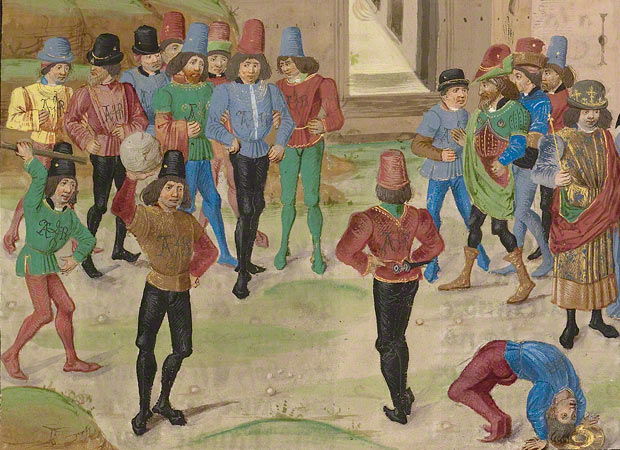
The Competition in Sittacene and the Placating of Sisigambis (detail) in Book of the Deeds of Alexander the Great, illuminations attributed to the Master of the Jardin de vertueuse consolation, about 1470–75
Tights are back.
In mid-15th-century England, a law restricted the wearing of short tunics that revealed the male buttocks to members of the upper class. In works of art, men of this, um, standing are often depicted wearing what we would call tights or leggings (hose) beneath their skimpy tunics. In today’s world, such tight-fitting leg garments were, until recently, reserved for ballet, the theater, Halloween, certain sporting events, and historical reenactment festivals.According to the “Tights Are Not Pants” manifesto, these aforementioned situations represent “historically acceptable acts of pantlessness.” The manifesto was written in response to the recent surge in women choosing tights as an alternative to pants, even if barely covered by a flimsy top. The “gratuitous divulgence of assets” amounts to the fashion equivalent of TMI.
Just as some today are alarmed at these acts of pantlessness, so too were some living in the Middle Ages. One author from the 14th century considered thinly disguised buttocks to be a deformation for otherwise honest men, and a Parisian bishop from the same time period preached that this type of dress was utterly shameful. Historical examples of tights-as-pants are on view in Fashion in the Middle Ages, our exhibition of medieval manuscripts that closes this Sunday.
In fact, two manuscripts in the gallery show men garbed in short tunics with their round backsides in plain sight. The image shown here comes from a book recounting the intrepid adventures of Alexander the Great, but the artist has clothed the figures in courtly dress of the late 1400s. We’ve explored the other image here.
Did you spot the tights being worn by the brilliantly clad noblemen, who are actually supposed to be Alexander’s soldiers? They look far too fancy to do any real fighting.

Where do you stand on this heated debate? At least, as Roger Wieck points out, we have been spared one other fashion oddity of medieval times: miniskirts for men. Will they be next?




I dont see why men are not wearing tights anymore. Because of my job, sitting all day, and the fact I have mild water in one leg, I am now wearing tight footless leggings. They are so comfortable! The other day I ventured out in them without covering trousers and nobody seemed to notice. But then running tights are quite common now on men and women. One day male fashion will return tights to men, women having stolen then, but sadly probably not in my lifetime. I am almost 57 now. Cant wait to go out in my footless tights again!!!!
I predict men and boys will be wearing tunics and tights within 20 years.
Hi Kim, I LOVE Renaissance clothing and wear tights to practice ballet in. What are your thoughts about men wearing tights?
They have been back a while. Look at Kanye West the primary modern arbiter of medieval fashion
Although not tights I do regularly wear an over-sized shirt that is at least 3X extra large- sometimes with a belt or a scarf tied around my waist – over slim-fit pants (trousers), leggings or jeggings depending on the weather. In very hot weather, I forgo the leg garments and just wear the shirt and belt.
Wearing tights / pantyhose I wear daily great fashion and wear them as a fashion item of clothing. Seeing my collection is like walking into a hosiery store of all colors and many styles. Is about time men can enjoy fashion freedom not the dull ole colors. Not to be ridiculed and called names there are many men that wear more then people know they are worn under their pants so not to be shamed by the public Kim.
It’s 2018 almost 2019 now. It’s already happening Kim. I wear leggings with shirts long enough to be decent. Basically the same as tights with a tunic.
Once you put them on, you prefer them over all other bottoms. Especially men’s leggings. More and more guys are starting to do it. It’s also good because it causes you to more conscience about your weight.
I wear tights or pantyhose daily all day long. I wear all colors and styles nothing is off limits not that brave to wear openly because of public ridicule and name calling . When out I wear them under my pants at home with or without shorts and when I take photos usually with a mini skirt for photo purposes am a straight male and no I don’t crossdress.
I agree with u on that
Still working 50,60 hrs a week standing i have varicose veins in both legs. support tights would be ideal, ifSome one started advertising them and there benifits, then ill wear them.
I was reading this article and thought what? Then I realized it was from 2011.
Well in 2018 going on 2019, tights are definitely pants again. The ladies said so.
Not only that, the guys are also saying so. Guys are also wearing leggIngs and are ditching the shorts over their tights look now. Although we tend to keep our shirts longer to remain decent.
Leggings are just too comfortable to ignore. The compression and spandex technology makes them the ideal fit. Once you wear them, you prefer them.
So it looks like we’re all heading back to Medieval times. This time both men and women are going to be wearing tights as pants. The baggy fit people will be considered the new fashion Faux Pas.
If you look at some of the paintings from the Medieval times, tops or shirts that men wore seem to stop sometimes at the stomach. Then you see the tights begin. Well in many of those paintings you can clearly see the man’s bulge. I guess in Medieval times this was not a big deal. In fact in some of those paintings the bulge is very pronounced. It is though the tights were made to show the bulge in all it’s glory. But I wonder if that was just the painter over doing it with his brush. Or just as men today show off their manliness by building big chestsand arms, so men in that time showed off their manliness by highlighting the bulge as much as possible. But today I am not sure if a man wearing tights where his bulge showed would fly in our modern society. I could see it where if it was just a bunch of guys hanging out together showing off their manliness, maybe. But if tights on men become the norm, most likely men will have a long shirt of some type or at least in public.
That’s how it is. I wear a longer shirt to cover my bulge. But the funny thing is, there are some naughty ladies out there who try to position themselves to see the bulge.
So you’re not putting it on display, but then they might sit or move to a spot where they can see it.
That has happened to me a few times before. In my opinion, that’s not the fault of the guy. That’s the woman or, whoever, specifically trying to be naughty.
It would be equivalent to a guy trying to sneak a peek up a ladies skirt.
But well made tights/leggings for guys have well made gussets to deemphasize a guy’s package. It’s still his responsibility to wear a decent length top. But he can’t be held responsible for the perverted behavior of others.
Once you try tights there may be no going back! If this sounds weird, then so be it.
I wear tights every chance i get. While i generally enjoy ogling mens crotches (k, maybe i am not completely striaght) i try to minimize the pronouncement of my genitals. Thongs are the most comfortable underwear for me to wear, and i love the absence of underwear lines showing through the tights. BUT, most men’s thongs are DESIGNED to hold us up and out, enhancing the appearance of the bulge. I do find this off-putting. My recent discovery is that a properly sized WOMENS thong will hold my bits in place without making it look like i am in your face with my package. I think we do a lot of penis shaming, especially here in America, and i fully believe that is wrong. At the same time, when in tights i just like to present myself as “androgynous” as possible. Would you be willing to try a thong made for women?
I don’t see anything wrong when men wear leggings. I don’t think that top should be long to cover buttocks and genital area. It doesn’t matter at all. Stretchy and quite tight leggings is very healthy for blood circulation, muscles and extremely good for all sorts, because they do not handicap any motion so they are good for kicks, splits and therefore dancing and splits so they are better for martial arts than traditional kimonos, are tight, and good for swimming, improve blood circulation and reduce muscle circulation. They are good for all sports and very comfortable for everyday walking and any activity when worn on nude body. Stretchy and very tight leggings reduce muscle soreness very well. If a guy is slim and fit then women consider such guy in leggings sexy. There is no single reason not why men shouldn’t wear leggings. Is there?
During the Middle Ages men wore hose, not tights as we would know them today. They did not have the synthetic yarns that we have now. It also tended to be the nobles and well placed in society who wore the fine clothes. The peasants had to make do with sack cloth and the like. Interestingly in modern times men have started to wear tights, either tights specifically made for men, or buying tights of a larger size intended for the female market. The gentleman in the photograph (follow link: https://www.deviantart.com/kimsherman/art/200-denier-black-opaque-tights-798241507 ) is wearing a pair of 200 denier black opaque tights bought from Marks and Spencer.